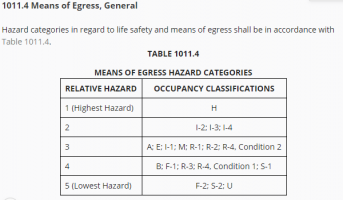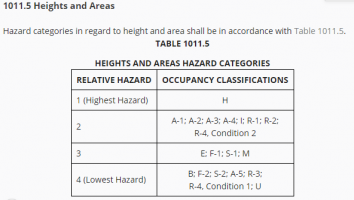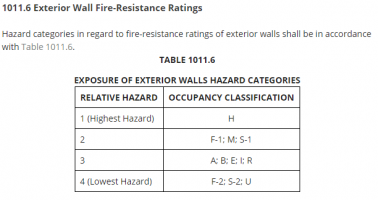-
Welcome to The Building Code Forum
Your premier resource for building code knowledge.
This forum remains free to the public thanks to the generous support of our Sawhorse Members and Corporate Sponsors. Their contributions help keep this community thriving and accessible.
Want enhanced access to expert discussions and exclusive features? Learn more about the benefits here.
Ready to upgrade? Log in and upgrade now.
You are using an out of date browser. It may not display this or other websites correctly.
You should upgrade or use an alternative browser.
You should upgrade or use an alternative browser.
Not an IEBC person
- Thread starter cda
- Start date
What ClassicT posted are the only references in the IEBC, but these are specific to the indicated applications and are not intended as a means to generally classify occupancies by relative hazard. You can probably extrapolate a basic classification based on the information the tables provide, but it would not be something that could be used for enforcement.
Builder Bob
SAWHORSE
Generally, a higher hazard requires more changes than a same hazard or lower hazard - The trick with the IEBC is to use one of three methods _ Prescriptive (Chapter 4), Alteration level (1-III, change of occupancy, addition), or the performance portion of the code. This is the designer's job to convey which method they are choosing for compliance.
We recently had a building where the electrical room was being modified to provide for enclosed stairways - however, it was discovered that the primary internet fiber line ran across the proposed location for the new door - The designer was able to use the performance code to circumvent prescriptive means of the code to allow access to the electrical room thru the stairway - a little unorthodox but the life safety and means of egress scores were sufficient even with the ding caused by the stairway SNAFU.
Not a great design, however the changes being provided are bringing the existing four story community college building more code compliant than before. - In other words, the stairway dings still scored high enough that one of four stairways did not have to be fire rated or enclosed. (One of the few times that the performance portion of the IEBC was beneficial to the architect and to the college.)
We recently had a building where the electrical room was being modified to provide for enclosed stairways - however, it was discovered that the primary internet fiber line ran across the proposed location for the new door - The designer was able to use the performance code to circumvent prescriptive means of the code to allow access to the electrical room thru the stairway - a little unorthodox but the life safety and means of egress scores were sufficient even with the ding caused by the stairway SNAFU.
Not a great design, however the changes being provided are bringing the existing four story community college building more code compliant than before. - In other words, the stairway dings still scored high enough that one of four stairways did not have to be fire rated or enclosed. (One of the few times that the performance portion of the IEBC was beneficial to the architect and to the college.)
BayPointArchitect
Sawhorse
Below is another rank of occupancies that is not enforceable.
This is based on some fuzzy math and 2012 IBC Table 503. Which gives us the allowable building heights and areas.
Again I say that this is entirely worthless but I have this posted near my desk anyway.
The purpose is to help my coworkers understand that when we have a change in occupancy from one thing to something less hazardous, then we should not scrutinize the project to the point that we kill it entirely.
Highest Hazard
H-2 Hazard - Flammable Gas & Liquids
U Miscellaneous or private garage
I-1 Institutional - Assisted Living
H-1 High Hazard - Explosives
I-3 Institutional - Detention Center
A-* Assembly - Restaurant, Church, etc.
H-3 Hazardous - Consumer Fireworks
I-2 Institutional - Hospital
M Mercantile
I-4 Institutional - Daycare
R-* Residential Facilities + Sleeping Units
H-4 Hazardous - Toxic Materials
F-1 Factory - Moderate
E Educational
S-1 Storage - Combustible
H-5 Hazardous - Semiconductor Factory
B Business
F-2 Factory - Low Hazard
S-2 Storage - Noncombustible
Lowest Hazard
This is based on some fuzzy math and 2012 IBC Table 503. Which gives us the allowable building heights and areas.
Again I say that this is entirely worthless but I have this posted near my desk anyway.
The purpose is to help my coworkers understand that when we have a change in occupancy from one thing to something less hazardous, then we should not scrutinize the project to the point that we kill it entirely.
Highest Hazard
H-2 Hazard - Flammable Gas & Liquids
U Miscellaneous or private garage
I-1 Institutional - Assisted Living
H-1 High Hazard - Explosives
I-3 Institutional - Detention Center
A-* Assembly - Restaurant, Church, etc.
H-3 Hazardous - Consumer Fireworks
I-2 Institutional - Hospital
M Mercantile
I-4 Institutional - Daycare
R-* Residential Facilities + Sleeping Units
H-4 Hazardous - Toxic Materials
F-1 Factory - Moderate
E Educational
S-1 Storage - Combustible
H-5 Hazardous - Semiconductor Factory
B Business
F-2 Factory - Low Hazard
S-2 Storage - Noncombustible
Lowest Hazard



